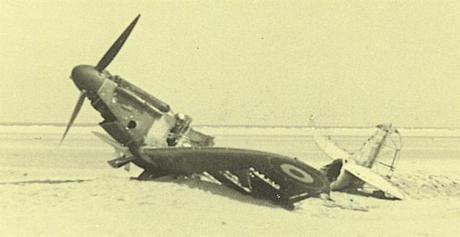posted by author Charles McCain
http://charlesmccain.com/In the first months of the long air battle over Great Britain between the Royal Air Force and the Nazi Luftwaffe, only 20% of RAF pilots who ditched into the English Channel survived. They were either killed in the air or in their crash into the Channel or by hypothermia brought on by immersion in the cold water of the English Channel.

In the first months of the war, RAF fighter pilots didn't even have dinghies. Large aircraft such as RAF bombers used over France had rudimentary survival equipment. But procedures for ditching were not well established when the war began and the men were not trained in what actions to take in event of a ditching. Complicating matters, portable emergency radios were not available at the beginning of the war and when they became available they were unreliable and often didn't work if they got wet. A drawback as you can see.
In the 20 or 30 seconds the air crew had before the plane sank, they had to both grab and then push or pull through the upper hatches whatever emergency equipment they could: inflatable small rubber dinghies, emergency ration packs with fresh water, flare pistol if they had one, a portable radio transmitter if they had one and, of course, the pigeons. As the war went on, bombers were fitted with larger inflatable rubber dinghies stored outboard.
An immersion switch triggered the release mechanism of the large outboard dinghy which then automatically broke free of the aircraft and inflated. The rubber boats were connected to the plane by a long rope so they would not float away. In rough seas, these large dinghies had a tendency to flip over before the men got in them. Thus the emergency supplies stored in the dinghies often were lost.
Nonetheless, the dinghies were critical to the survival of the aircrew. If the men only had their life jackets and weren't in a dinghies, they could only survive in the English Channel for two to four hours. Since the water in the Channel was cold year round, exposure/hypothermia killed the men in a few hours if they were immersed with only their life jackets keeping them afloat.
For example, from 10 July to 31 July 1940 during the Battle of Britain, 220 RAF aircrew were totaled as missing presumed dead, mostly because they had come down in the English Channel. In October 1940, 260 aircrew were missing presumed dead. Once again most had ditched in the English Channel.
[figures from Shot Down and In the Drink: RAF and Commonwealth Aircrews Saved From the Sea 1939 to 1945 by Air Commodore Graham Pitchfork MBE (Member of the Most Excellent Order of the British Empire), BA, FRAeS (Fellow of the Royal Aeronautical Society)]

(photo courtesy of gallery.nen.gov.uk/asset651563)
http://charlesmccain.com/2014/02/fighting-to-stay-aloft-and-not-go-into-the-drink/

Author Bio: My first novel, An Honorable German, about a heroic and conflicted German U-Boat Commander, was published in May 2009 right after I survived a bout with lymphoma. Through the Grace of God and the brilliance of Dr. Wydham Wilson, PhD, MD and his deputy genius, Kieron Dunleavy, MD, of the lymphoma team of the National Cancer Institute, I was cured and have spent the time since recovering and working on both my blog and future works.
